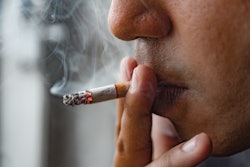
Have you noticed that vaping is the new rage, especially among Gen Z? According to Gallup, 1 in 20 Americans are e-cigarette users. Truth Initiative reports that 27% of high schoolers use a vape product, and the U.S. Food and Drug Administration states that vaping has increased by 1,800% since 2011, with more than 5 million middle and high school students in the U.S. using e-cigarettes. Of the users polled, 1 in 5 Americans are ages 18 to 29 compared to 16% of those ages 30 to 64. Indeed, it is all the rage.
Have you thought about how this issue will be handled in your office? It wasn’t that long ago that practice owners implemented a no-smoking policy within their practices. Is a non-vaping policy next? With its popularity soaring, it is time to consider how to handle employees and patients who vape in and at the office.
The problem is that an e-cigarette is more difficult to police, since a quick hit dissipates before you realize it has happened. There are also so many unknowns regarding the effects of the product. We will discuss some of the facts so you can make an educated decision on the best policy for your practice.
Unfortunately, we are still learning about the health effects of vaping. It is akin to the lack of knowledge in the '50s and ‘60s about the long-term effects of smoking cigarettes. Vaping hasn’t been around long enough to know what the long-term effects are on one's health.
Here is some information on vaping that is provided to us by the U.S. Centers for Disease Control and Prevention, the FDA, and various health organizations:
- Vaping is thought to be less harmful than smoking, but it is still not safe. While some may believe it's a good replacement for smoking cigarettes, we simply do not know the long-term health effects of vaping.
- The vapor of e-cigarettes comprises a mixture of propylene glycol, glycerin, nicotine, and flavorings.
- Research shows that vaping raises your blood pressure and spikes your adrenaline, which in turn increases your heart rate. People who vape are 56% more likely to have a heart attack and 30% more likely to have a stroke.
- Vaping can lead to nicotine addiction as well as an increased risk of addiction to other drugs.
- Did you know that cigarette smoke contains more than 7,000 chemicals? E-cigarette aerosols have lower levels of chemicals than cigarette smoke, but any tobacco product is unsafe.
- Vapes contain harmful chemicals, like those found in nail polish remover, weed killer, and bug spray. Some chemicals found in the vapors are acrolein and acetaldehyde, which we know can damage your lungs. These chemicals are known to cause lung disease and cancer.
- The lungs can be scarred by inflammation and irritation due to vaping, causing “popcorn lung.”
Recently on a flight that I took, flight attendants asked several times over the cabin speakers that passengers stop vaping on the plane. In the initial briefing before take-off, the flight attendants announce to passengers that smoking and vaping are prohibited. Planes are grounded for a minimum of two hours and must undergo a thorough check of the systems and engines if the smoke alarms go off on the plane.
How are rental car companies and hotels handling people who vape in rental cars and hotel rooms? They levy hefty fines.
A friend who works in a corporate environment recently shared an email with me that was sent to all of the employees:
We are updating our office policies with an official policy on vaping; see below:
To ensure the well-being of all employees and to maintain a professional and clean working environment, the use of vaping devices, as well as all other tobacco products, is strictly prohibited in the office.
If you see an employee vaping, please ask them not to vape in the office. If the occurrence happens again, please let one of us in HR know so we can address it.
Apparently, prior to this notice, vaping in the office was acceptable. It wasn’t until there were complaints that the company issued the new policy.
There have been studies about secondhand vape exposure, which show that the aerosols contain nicotine and harmful toxins, which means you are exposing others to these chemicals when you vape around them.
The U.S. National Institutes for Health did a study that showed vape aerosols only stay in the air for about 10 to 15 seconds compared to conventional cigarettes, which can take minutes to dissipate. That is better, but there is still exposure that we need to be aware is happening and that can concern others.
Some additional statistics, include the following:
- More than 10% of teens claim to vape because it makes them look cool.
- Approximately 51.2% of e-cigarette users in the U.S. are under the age of 35.
- About 20% of 12th graders have reported vaping marijuana.
- Turkey banned e-cigarettes in 2008, and residents can only currently purchase vaping products online.
- Thirteen countries and jurisdictions have banned the use of e-cigarettes and vaping products completely in public places.
- On Jan. 1, 2020, the minimum age for purchasing tobacco products (including e-cigarettes) became 21 in the U.S.
We haven’t even discussed the effects vaping has on a patient’s dental health. We are seeing several changes in the oral cavity with vaping as well, including:
- Yellow or brown staining of teeth due to the interactions of nicotine and saliva
- Dry mouth
- Decay due to reduced blood circulation and an inability to fight off bacteria
- Gingival inflammation can be generalized, or at a minimum, the gingiva can be inflamed around the area where there is direct contact with e-cigarettes
Now that you have some facts, it is time to set a policy for your practice. It is advisable to set a policy in place now before any problems arise. In the future, vaping will be treated the same as smoking.
However, this issue isn’t going away anytime soon. It is a topic that you need to address sooner rather than later. You do not want someone to get sick with potential health issues because you turned a blind eye.
Whatever you decide for your policy, put it in writing and have everyone on the team sign an acknowledgement signaling their awareness and acceptance of your practice's vaping policy. While you may not currently have a vaping policy in your employee handbook, your employer policies are fluid and should be reviewed at least yearly or whenever necessary. Now may be a good time to update your employee handbook with a policy on vaping.
Clean air policies currently only pertain to smoking. However, it is the responsibility of employers to protect the health of all employees.
When it comes to working at a dental practice, Janice Janssen has seen and done it all. She has worked as a dental hygienist, as well as in other roles, including office management, insurance billing, and collections. As co-founder of Global Team Solutions, Janice is also a certified fraud examiner (CFE), which positions her as an expert in dental practice fraud and embezzlement.




















